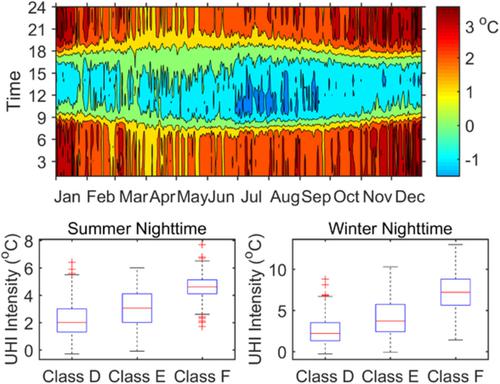当前位置:
X-MOL 学术
›
Atmos. Sci. Lett.
›
论文详情
Our official English website, www.x-mol.net, welcomes your feedback! (Note: you will need to create a separate account there.)
Urban heat islands in Hong Kong: Bonding with atmospheric stability
Atmospheric Science Letters ( IF 3 ) Pub Date : 2021-02-16 , DOI: 10.1002/asl.1032 Weiwen Wang 1 , Bingyin Chen 1 , Yong Xu 2 , Wen Zhou 3 , Xuemei Wang 1
Atmospheric Science Letters ( IF 3 ) Pub Date : 2021-02-16 , DOI: 10.1002/asl.1032 Weiwen Wang 1 , Bingyin Chen 1 , Yong Xu 2 , Wen Zhou 3 , Xuemei Wang 1
Affiliation

|
A barrier to urban heat island (UHI) mitigation is the lack of quantitative attribution of the various contributions to UHI intensity. This study demonstrates the daily and seasonal dynamics of UHIs in Hong Kong, a subtropical high-density city. The nocturnal UHIs of the city are grouped according to various dynamic stability conditions (neutral, weak stable, and strong stable) of the boundary layer. Results indicate that the stronger the atmospheric stability, the more intense the UHI. The atmospheric anomalies linked to these stability classifications are hence revealed. In summer, nights of neutral (strong stable) stratification are controlled by low (high) pressure with rising (sinking) motion, less (more) precipitation, and lower (higher) air temperature at the surface. In winter, the influence of the large-scale circulation system of the East Asian winter monsoon is significant. In the upper layer, the East Asian jet stream retreats westward (is displaced northward) on nights with neutral (strong stable) atmospheric stratification. At the surface, southeast China is hot and humid on neutral nights, while on strong stable nights, the coastal regions of southeast China are dry, and East Asia is dominated by positive surface air temperature anomalies. Atmospheric anomalies are generally nonsignificant on nights with weak stable stratification in both summer and winter. These findings provide potential predictors for UHI intensity.
更新日期:2021-02-16



























 京公网安备 11010802027423号
京公网安备 11010802027423号